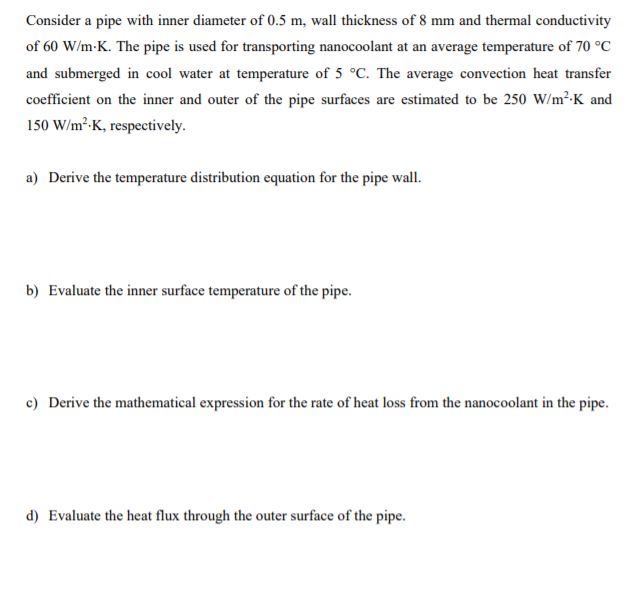of 60 W/m-K. The pipe is used for transporting nanocoolant at an average temperature of 70 °C and submerged in cool water at temperature of 5 °C. The average convection heat transfer coefficient on the inner and outer of the pipe surfaces are estimated to be 250 W/m²-K and 150 W/m²-K, respectively. a) Derive the temperature distribution equation for the pipe wall. b) Evaluate the inner surface temperature of the pipe. c) Derive the mathematical expression for the rate of heat loss from the nanocoolant in the pipe.
of 60 W/m-K. The pipe is used for transporting nanocoolant at an average temperature of 70 °C and submerged in cool water at temperature of 5 °C. The average convection heat transfer coefficient on the inner and outer of the pipe surfaces are estimated to be 250 W/m²-K and 150 W/m²-K, respectively. a) Derive the temperature distribution equation for the pipe wall. b) Evaluate the inner surface temperature of the pipe. c) Derive the mathematical expression for the rate of heat loss from the nanocoolant in the pipe.
Principles of Heat Transfer (Activate Learning with these NEW titles from Engineering!)
8th Edition
ISBN:9781305387102
Author:Kreith, Frank; Manglik, Raj M.
Publisher:Kreith, Frank; Manglik, Raj M.
Chapter1: Basic Modes Of Heat Transfer
Section: Chapter Questions
Problem 1.45P: An electronic device that internally generates 600 mW of heat has a maximum permissible operating...
Related questions
Question

Transcribed Image Text:Consider a pipe with inner diameter of 0.5 m, wall thickness of 8 mm and thermal conductivity
of 60 W/m-K. The pipe is used for transporting nanocoolant at an average temperature of 70 °C
and submerged in cool water at temperature of 5 °C. The average convection heat transfer
coefficient on the inner and outer of the pipe surfaces are estimated to be 250 W/m²-K and
150 W/m²-K, respectively.
a) Derive the temperature distribution equation for the pipe wall.
b) Evaluate the inner surface temperature of the pipe.
c) Derive the mathematical expression for the rate of heat loss from the nanocoolant in the pipe.
d) Evaluate the heat flux through the outer surface of the pipe.
Expert Solution
This question has been solved!
Explore an expertly crafted, step-by-step solution for a thorough understanding of key concepts.
Step by step
Solved in 3 steps with 3 images

Knowledge Booster
Learn more about
Need a deep-dive on the concept behind this application? Look no further. Learn more about this topic, mechanical-engineering and related others by exploring similar questions and additional content below.Recommended textbooks for you

Principles of Heat Transfer (Activate Learning wi…
Mechanical Engineering
ISBN:
9781305387102
Author:
Kreith, Frank; Manglik, Raj M.
Publisher:
Cengage Learning

Principles of Heat Transfer (Activate Learning wi…
Mechanical Engineering
ISBN:
9781305387102
Author:
Kreith, Frank; Manglik, Raj M.
Publisher:
Cengage Learning